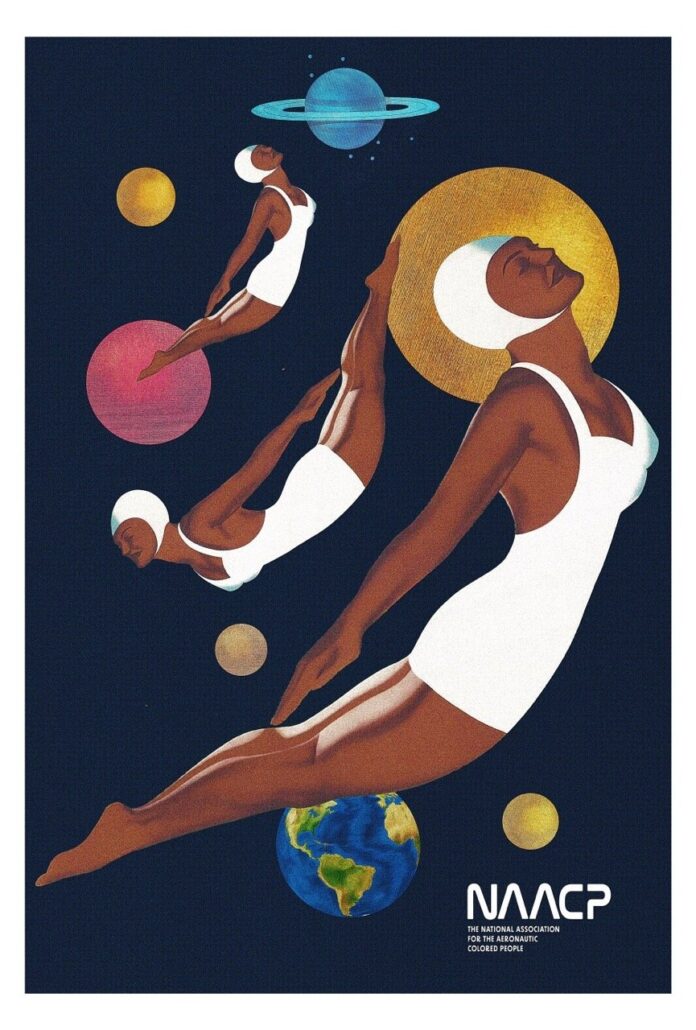“Diasporic Connections” is dominated by the painting and sculpture of Chidinma Dureke, who was born in D.C. to parents of Nigerian descent. Also outstanding are the digital collages of Maurice James Jr., who uses found imagery to reimagine the place of African Americans in U.S. history.
The other four artists selected by curator Atiya Dorsey contribute just a few works. Chuckwunonso Angel Dureke (Chidinma’s sister) offers a video study of the Cameroon-born operator of a local hair-braiding salon. Two indigo-dyed canvases of reversed human figures demonstrate Bakari Akinyele’s mastery of fabric techniques from places as distant as Ghana and South Korea. Kluse’s photographs, mostly street scenes, are printed as transparencies to give a sense of depth and motion. Lew is represented by a single painting of the street signs at Ninth and U streets NW, an intersection that marks the area known as “Little Ethiopia.”
Chidinma Dureke paints realist portraits, some of which convey cultural identity by incorporating Nigerian consumer products. The woman in “Madonna and Child” cradles not a baby but a can of custard powder. Among Dureke’s sculptures are Warhol-like oversize models of such processed-food packages as a box of sugar cubes and a can of evaporated milk. The latter wryly riffs on the popular notion that you are what you eat by including a nutrition information panel that’s not for the milk. It’s for people: a DNA breakdown of mixed African and European heritage.
Where Dureke enshrines mass-market products, James smartly adapts vintage graphics to devise alternate histories. In a poster extolling space exploration, he combines the logos of two very different organizations to concoct the National Association for the Aeronautic Colored People. A mid-20th-century rail-travel poster and the insignia for London’s Underground rail system are combined in a placard that alludes to both the Underground Railroad and the Great Migration. In James’s reinvented past, Black America is confidently on the move, whether to Chicago or the moon.
The title of Tella’s “Expansion of Oyo” refers to the province of her birth, and to the empire of the same name that lasted from the 14th to the 19th centuries. The show includes a three-minute video in which masked people perform rituals, but it consists mostly of paintings of people with dark blue skin. This distinctive flesh tone contrasts brightly colored clothing, as well as jewelry and other accents rendered in gold leaf.
The suburban Maryland artist distinguishes her subjects less by innate physical characteristics than by attire. Indeed, her style is reminiscent of fashion illustration. Subtly adding to the pictures’ complexity are white-on-white patterns inscribed in relief behind the figures. What initially appear to be blank backdrops turn out to be intricate arrays of lines and dots that evoke centuries of West African decorative practices.
Chopped-down trees come back to life — but only partway — in Lorio’s sculptures, each one a warning of ecological despoilment. The centerpiece of the local artist’s “Sustainable” is an installation of about a dozen modestly scaled pieces linked by an expanse of wooden pellets covering much of the gallery’s floor. Lorio’s assemblages don’t emulate full trees. Instead, they take the form of logs, stumps or slices of thick trunks. The artist also constructs unnatural objects such as a tower made of smooth-sided stakes.
Most of Lorio’s creations are built of pencil-size wooden rods, joined with a precision worthy of a Japanese temple. This show’s array, which includes five wall-mounted pieces, is varied by assorted shapes and the occasional use of bark, whose cragginess contrasts the meticulousness of Lorio’s craftsmanship.
The show’s most important components, however, may be those industrially produced pellets. They’re of the sort made from trees in the American South and exported to Europe, where they’re burned in power plants due to a controversial loophole in European regulations. Environmentalists decry the notion that this practice is, yes, “sustainable.” For a Louisiana-born artist who is trying to put trees back together piece by piece, the pelletization of Southern forests is both a threat and an affront.
Diasporic Connections Through Jan. 27 at Studio Gallery, 2108 R St. NW. studiogallerydc.com. 202-232-8734.
Oluwatoyin Tella: Expansion of Oyo and George Lorio: Sustainable Through Jan. 28 at IA&A at Hillyer, 9 Hillyer Ct. NW. athillyer.org. 202-338-0680.
The pictures and sculptures in Kyrae Dawaun’s Hamiltonian Artists show are discrete entities, yet they feel like elements of a single suite. “The Irony of Capacity: A Dark, Black Comedy” juxtaposes paintings, most of them small, with constructions of things both present and absent. Among the most compelling pieces are the feigned voids of the local artist’s “Hole in the Wall” series. These particleboard fabrications are mounted away from the wall, not flush with it, yet simulate areas in which wooden planks have been partly removed to reveal a dim passageway into something or somewhere.
The illusion doesn’t read as especially destructive. But there are hints of violence in other sculptures: the chunk of twisted metal inside an open drawer in a sort of chest or the bullet-like holes that mar a hanging rectangle made of heavy, dark materials.
Dawaun paints with oil on wooden panels, a classical format, but in a loose style. Many of the pictures are titled “Reassembler” followed by a single name, and apparently depict such Black notables as Dick Gregory or Frank Ocean. Strong likenesses are less important, however, than spontaneous gestures and a dark, brown-heavy palette. Like Dawaun’s illusory holes in the wall, these near-portraits sketch a path into the shadows.
Kyrae Dawaun: The Irony of Capacity: a Dark, Black Comedy Through Jan. 27 at Hamiltonian Artists, 1353 U St. NW. hamiltonianartists.org. 202-332-1116.



